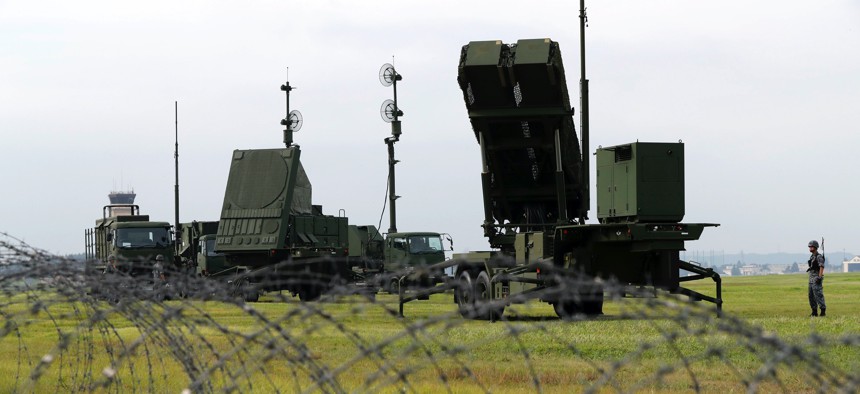
The Japan Air Self-Defense Force demonstrates the PAC-3 surface to air interceptors at Yokota Air Base outside Tokyo in 2017. AP / Eugene Hoshiko, File
Army General Wants More Missile Defense Within First Island Chain
“I don't think we have enough right now,” Maj. Gen. Vowell said.
The top soldier in Japan believes the Indo-Pacific region needs more defenses against aircraft and missiles from China, Russia, and North Korea.
“I don't think we have enough right now. I think we need more. And so that would be, as the commander of U.S. Army Japan, I think that would be something that I would champion for, is more integrated air and missile defense protection in the first island chain, for certain,” Maj. Gen. Joel Vowell said Tuesday during Defense One’s Outlook 2022 event.
Air and missile defense is one of five “core tasks” the Army would undertake to support the joint force in the Indo-Pacific if conflict broke out, Army Secretary Christine Wormuth said recently.
“We will be able to interdict fires across sea lines of communication, suppress enemy air defenses, and provide counter fires against mobile targets,” Wormuth said last week.
She noted that China has missiles that can reach Japan and Guam, such as the Dong Feng-26. North Korea continues to develop its nuclear program and has been testing its missiles for years, with some falling into or being fired into the Sea of Japan. Russia wants the United States out of the northern Indo-Pacific, he said, and is attempting to force the issue by producing more cruise missiles to threaten American and Japanese forces.
All this means the U.S. needs a variety of missile defense systems to intercept them all, Vowell said.
“We have to make sure we have enough to protect and intercept in case they're used. That's the nature of deterrence as well,” he said.
The United States has Patriot missile batteries in Japan that can detect and shoot down missiles coming from the Asian continent. The Japanese military has Patriots of its own, plus other missile defenses that are integrated with U.S. forces, he said.
In November, the Army tested Israel’s Iron Dome anti-rocket system to see whether it could protect U.S. territory from a Chinese missile. Aegis Ashore could also be used in the region to track missiles.
China’s recent test of a hypersonic missile revealed that China is more advanced in this area than the United States. The Chinese missile orbited the earth and then hit a target; the U.S. military is still working to develop its own hypersonic weapons.
Vowell said what concerned him about the test, based on media reporting, was that when the missile went into orbital flight, it became harder to detect in certain areas of the globe.
“As I understand it, I don't think it hit its mark exactly. But that doesn't matter. It's still a test. And what it tells me as a military officer is China's determined to get some leap ahead capability or technology that's very lethal and could hold forces, formations at risk in a way that we can't deter,” he said.
The Multi-Domain Task Force assigned to the Pacific region, and based out of Joint Base Lewis McChord in Washington State, is tasked with addressing hypersonics, as well as cyber, space, and electronic warfare, Vowell said.




